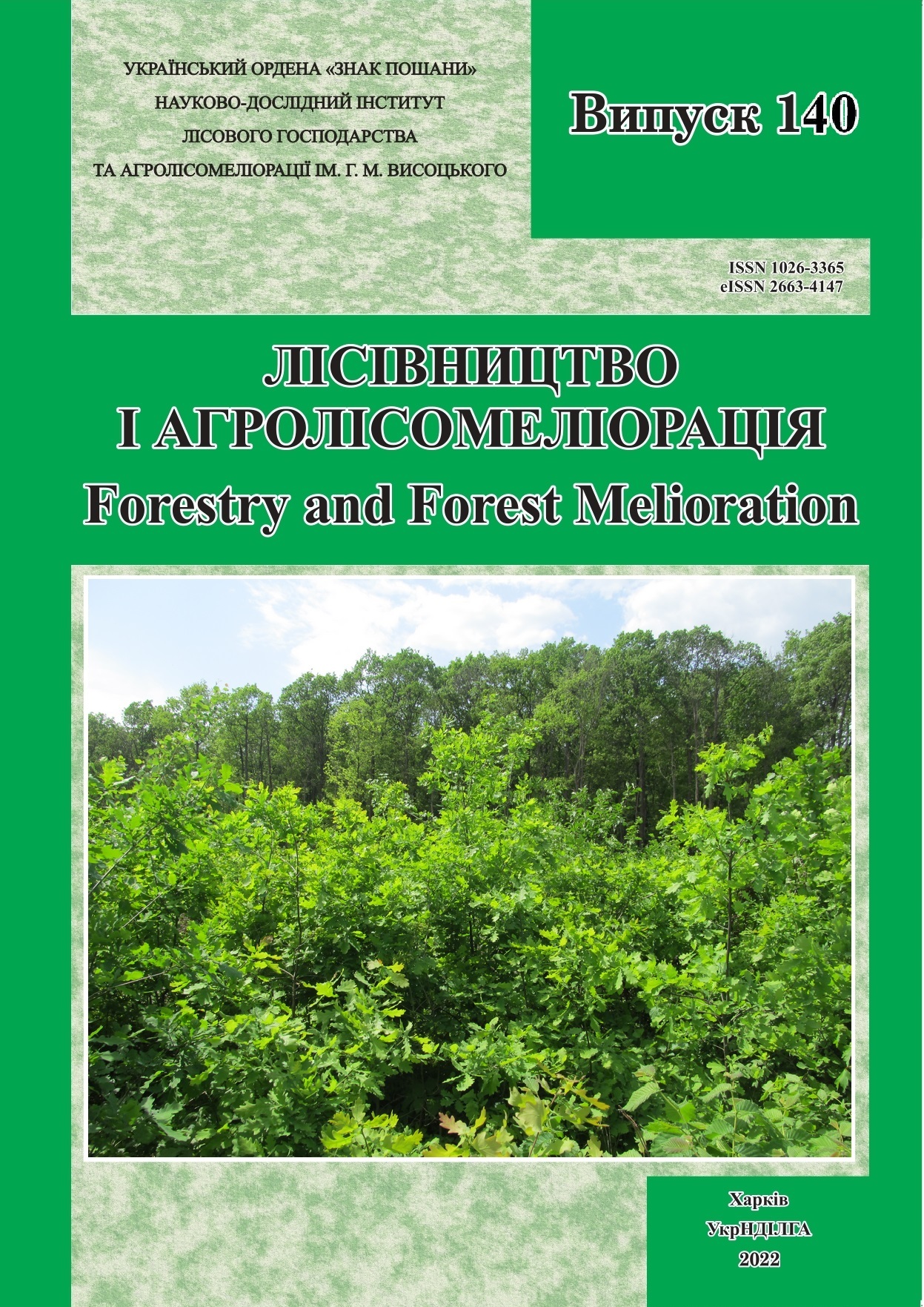Abstract
Introduction
Pine forests perform climate-regulating, recreational, health-improving, environmental, and other important functions. They also meet the needs of the national economy and the population in wood and other forest products.
To determine the mode of use and effective forest management in pine forests, it is necessary to establish a functional purpose of the forest, which is determined by its belonging to a certain category.
The aim of the research was to analyse a functional distribution of the pine stands in Kharkiv region in terms of their origin and to determine their productivity by forest categories.
Materials and methods
The forest inventory data were the basis for the calculations. The study covers the pine stands of various origins, subordinated to the State Forest Resources Agency of Ukraine, within Kharkiv region in all forest categories with a total area of over 95 thousand hectares.
Pine forests within ten state forest enterprises were analysed.
The division of forests into categories and the allocation of special protective forest areas with a limited use mode were carried out in accordance with the Procedure of Division of Forests on Category and Determination of Protective Forest Areas. The age structure and productivity of the studied pine stands in terms of forest categories and their origin were determined according to the generally accepted methods in forest assessment.
Results
Recreational and health-improving forests (37.3%) and protective forests (32.7%) predominate among the pine stands by area. The forest area for environmental, scientific, historical and cultural purposes is 30.0%.
The most productive are the pine stands within recreational and health forests (315 m3·ha-1), and the least productive are those in protective forests (286 m3·ha-1).
The area is significantly dominated by planted pine stands, the part of which makes 92%; the rest of the area (8%) is occupied by natural pine stands.
The age structure of the pine forests is unbalanced, with the predominance as in area, so in stock of maturing pine stands of natural origin and middle-aged planted pine stands.
The average index of forest growth capacity used by natural pine stands in protective forests made 63%, in recreational and health-improving forests and in forests of environmental, scientific, historical and cultural purpose it made 64%. The indices of forest growth capacity used by the planted pine stands were slightly lower – 56, 58 and 54%, respectively.
Conclusions
The study revealed an unbalanced age structure of the pine stands of all categories in Kharkiv region. There was an essential predominance as in area, so in stock of maturing pine stands of natural origin and middle-aged pine stands of artificial origin. The share of young forest was insignificant, in particular that of natural origin.
The indices of forest growth capacity used by the pine stands, regardless of the forest category, were relatively low and made 63–64% for the pine stands of natural origin and 54–58% for planted ones.
3 Figs., 4 Tables, 10 Refs.
References
A comprehensive road map for improving management in lowland forests of Ukraine on the basis of ecologically oriented close-to-nature forest management. 2018. Tkach, V. P. (Ed.). Kharkiv, URIFFM, 51 p. (in Ukrainian).
Girs, A., Novak, B., Kashpor, S. 2013. Forest management. Kyiv, Phitosociocentr, 435 р. (in Ukrainian).
Hrom, M. M. 2010. Forest mensuration. Lviv, RVV NLTU, 416 p. (in Ukrainian).
Hudyma, V. D., Parpan, Т. V., Plikhtiak, P. P. 2018. The functional and age structure of the mountain forests of the Ukrainian Carpathians. Forestry and Forest Melioration, 133: 71–77 (in Ukrainian). https://doi.org/10.33220/1026-3365.133.2018.71
Rumiantsev, M. H., Borysenko, O. I., Yushchyk, V. S. 2021а. Pine stands of the steppe part of Kharkiv region: condition and productivity. Іnternational scientific innovations in human life. Proceedings of the 3rd International scientific and practical conference, 22–24 September 2021. Manchester, United Kingdom, p. 10–17 (іn Ukrainian).
Rumiantsev, M. H., Kobets, O. V., Yushchyk, V. S., Tupchii, O. M. 2022. Functional distribution of pine stands in Kharkiv region and their age structure. Modern challenges and current problems of forestry education, science and production. Proceedings of International Scientific and Practical Conference 15 April 2022 (Bila Tserkva, Ukraine), p. 27–30 (іn Ukrainian).
Rumіantsev, M. Н., Vysotska, N. Yu., Borysenko, O. I., Yushchyk, V. S., Khromulіak, O. I. 2021b. Current state and productivity of pine stands in Kharkiv region. Forestry and Forest Melioration, 139: 10–19 (in Ukrainian). https://doi.org/10.33220/1026-3365.139.2021.10
The procedure of division of forests on category and determination of protective forest areas. 2007. [Electronic resource]. Resolution of the Cabinet of Ministers of Ukraine No 733 dated 16 May 2007. Available at: https://zakon.rada.gov.ua/laws/show/733-2007-%D0%BF#Text (accessed 11.05.2022) (in Ukrainian).
Tkach, V. P., Kobets, O. V., Rumiantsev, M. Н. 2018. Use of forest site capacity by forests of Ukraine. Forestry and Forest Melioration, 132: 3–12 (іn Ukrainian). https://doi.org/10.33220/1026-3365.132.2018.3
Tkach, V. P. and Meshkova, V. L. 2019. Modern problems of formation and reproduction of biologically stable pine forests of Ukraine in conditions of climate change. Pine forests: current status, existing challenges and ways forward. Proceedings of International Scientific and Practical Conference 12–13 June 2019 (Kyiv, Ukraine), p. 70–78 (іn Ukrainian).

This work is licensed under a Creative Commons Attribution 4.0 International License.
